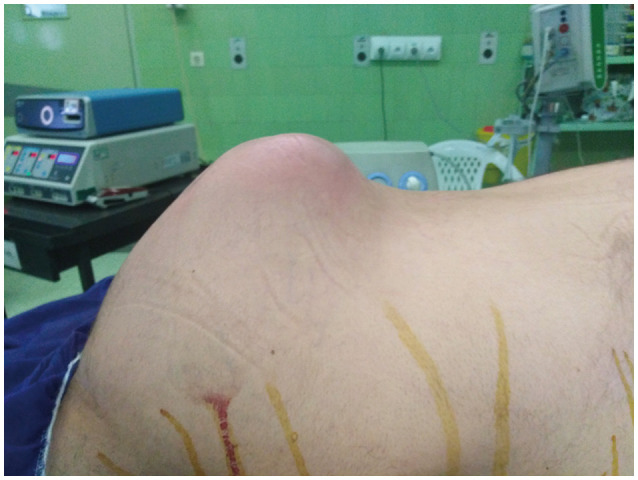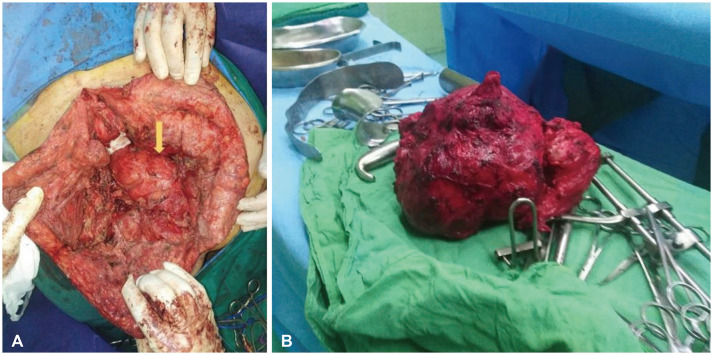Brain Tumor Res Treat.
2022 Jan;10(1):29-33. 10.14791/btrt.2022.10.e12.
A Giant Sacrococcygeal Chordoma: A Case Report
- Affiliations
-
- 1Departments of Neurosurgery, Mashhad University of Medical Sciences, Mashhad, Iran
- 2Departments of Radiology, Faculty of Medicine, Mashhad University of Medical Sciences, Mashhad, Iran
- KMID: 2525299
- DOI: http://doi.org/10.14791/btrt.2022.10.e12
Abstract
- Sacrococcygeal chordoma is a rare malignant bone tumor. Although there are tough membranes such as the periosteum and presacral fascia (which resist transgression by the tumors), chordoma usually invades the rectal wall. The serious problem with these tumors is the late diagnosis and its high likelihood to become enlarged. The main treatment options for this tumor is surgical resection, radiotherapy, and chemotherapy. Due to the tumor vicinity to important organs such as bladder and its neurovascular structures, it makes surgical excision extremely challenging. The aim of this study is to describe a 50-year-old man with a giant sacrococcygeal mass. The novelty of this case report is the huge and unique size of the tumor which has not reported previously as well the special surgical approaches performed to remove the tumor.
Keyword
Figure
Reference
-
1. Varga PP, Lazary A. Chordoma of the sacrum: “en bloc” high partial sacrectomy. Eur Spine J. 2010; 19:1037–1038. PMID: 20514500.
Article2. Hanna SA, Aston WJ, Briggs TW, Cannon SR, Saifuddin A. Sacral chordoma: can local recurrence after sacrectomy be predicted? Clin Orthop Relat Res. 2008; 466:2217–2223. PMID: 18584264.
Article3. Baratti D, Gronchi A, Pennacchioli E, Lozza L, Colecchia M, Fiore M, et al. Chordoma: natural history and results in 28 patients treated at a single institution. Ann Surg Oncol. 2003; 10:291–296. PMID: 12679315.
Article4. Farsad K, Kattapuram SV, Sacknoff R, Ono J, Nielsen GP. Sacral chordoma. Radiographics. 2009; 29:1525–1530. PMID: 19755609.
Article5. Jemal A, Siegel R, Ward E, Murray T, Xu J, Thun MJ. Cancer statistics, 2007. CA Cancer J Clin. 2007; 57:43–66. PMID: 17237035.6. Chugh R, Tawbi H, Lucas DR, Biermann JS, Schuetze SM, Baker LH. Chordoma: the nonsarcoma primary bone tumor. Oncologist. 2007; 12:1344–1350. PMID: 18055855.7. Lauer SR, Edgar MA, Gardner JM, Sebastian A, Weiss SW. Soft tissue chordomas: a clinicopathologic analysis of 11 cases. Am J Surg Pathol. 2013; 37:719–726. PMID: 23588366.8. Tirabosco R, Mangham DC, Rosenberg AE, Vujovic S, Bousdras K, Pizzolitto S, et al. Brachyury expression in extra-axial skeletal and soft tissue chordomas: a marker that distinguishes chordoma from mixed tumor/myoepithelioma/parachordoma in soft tissue. Am J Surg Pathol. 2008; 32:572–580. PMID: 18301055.9. Rekhi B. Primary, large extra-axial chordoma in proximal tibia: a rare case report with literature review and diagnostic implications. APMIS. 2016; 124:238–242. PMID: 26522887.10. Walcott BP, Nahed BV, Mohyeldin A, Coumans JV, Kahle KT, Ferreira MJ. Chordoma: current concepts, management, and future directions. Lancet Oncol. 2012; 13:e69–e76. PMID: 22300861.11. Housari G, González M, Calero P, Beni R, Lobo E. Sacral chordoma: management of a rare disease in a tertiary hospital. Clin Transl Oncol. 2013; 15:327–330. PMID: 22865326.12. Atalar H, Selek H, Yildiz Y, Sağlik Y. Management of sacrococcygeal chordomas. Int Orthop. 2006; 30:514–518. PMID: 16552577.13. Sung MS, Lee GK, Kang HS, Kwon ST, Park JG, Suh JS, et al. Sacrococcygeal chordoma: MR imaging in 30 patients. Skeletal Radiol. 2005; 34:87–94. PMID: 15480648.14. Rao BSS, Menezes LT, Rao AD, John SK. Sacral chordoma-a report oftwo cases. Indian J Surg. 2005; 67:207–209.15. Park L, Delaney TF, Liebsch NJ, Hornicek FJ, Goldberg S, Mankin H, et al. Sacral chordomas: impact of high-dose proton/photon-beam radiation therapy combined with or without surgery for primary versus recurrent tumor. Int J Radiat Oncol Biol Phys. 2006; 65:1514–1521. PMID: 16757128.16. McMaster ML, Goldstein AM, Bromley CM, Ishibe N, Parry DM. Chordoma: incidence and survival patterns in the United States, 1973-1995. Cancer Causes Control. 2001; 12:1–11. PMID: 11227920.17. Akiyama T, Yamamoto A, Kashima T, Ishida T, Shinoda Y, Goto T, et al. Juxtacortical chondroma of the sacrum. J Orthop Sci. 2008; 13:476–480. PMID: 18843465.18. Fourney DR, Gokaslan ZL. Current management of sacral chordoma. Neurosurg Focus. 2003; 15:E9.19. Bergh P, Kindblom LG, Gunterberg B, Remotti F, Ryd W, Meis-Kindblom JM. Prognostic factors in chordoma of the sacrum and mobile spine: a study of 39 patients. Cancer. 2000; 88:2122–2134. PMID: 10813725.
Article20. Ferraresi V, Nuzzo C, Zoccali C, Marandino F, Vidiri A, Salducca N, et al. Chordoma: clinical characteristics, management and prognosis of a case series of 25 patients. BMC Cancer. 2010; 10:22. PMID: 20109225.21. Cho HY, Lee M, Takei H, Dancer J, Ro JY, Zhai QJ. Immunohistochemical comparison of chordoma with chondrosarcoma, myxopapillary ependymoma, and chordoid meningioma. Appl Immunohistochem Mol Morphol. 2009; 17:131–138. PMID: 19521276.
Article22. Kayani B, Sewell MD, Hanna SA, Saifuddin A, Aston W, Pollock R, et al. Prognostic factors in the operative management of dedifferentiated sacral chordomas. Neurosurgery. 2014; 75:269–275. PMID: 24867206.23. Ishii K, Chiba K, Watanabe M, Yabe H, Fujimura Y, Toyama Y. Local recurrence after S2-3 sacrectomy in sacral chordoma. Report of four cases. J Neurosurg. 2002; 97:98–101. PMID: 12120660.24. Pillai S, Govender S. Sacral chordoma: a review of literature. J Orthop. 2018; 15:679–684. PMID: 29881220.25. Chandawarkar RY. Sacrococcygeal chordoma: review of 50 consecutive patients. World J Surg. 1996; 20:717–719. PMID: 8662159.26. Kishimoto R, Omatsu T, Hasegawa A, Imai R, Kandatsu S, Kamada T. Imaging characteristics of metastatic chordoma. Jpn J Radiol. 2012; 30:509–516. PMID: 22592289.27. Gerber S, Ollivier L, Leclère J, Vanel D, Missenard G, Brisse H, et al. Imaging of sacral tumours. Skeletal Radiol. 2008; 37:277–289. PMID: 18034341.28. Asavamongkolkul A, Waikakul S. Wide resection of sacral chordoma via a posterior approach. Int Orthop. 2012; 36:607–612. PMID: 22038441.29. Clarke MJ, Dasenbrock H, Bydon A, Sciubba DM, McGirt MJ, Hsieh PC, et al. Posterior-only approach for en bloc sacrectomy: clinical outcomes in 36 consecutive patients. Neurosurgery. 2012; 71:357–364. PMID: 22569060.30. Ozger H, Eralp L, Sungur M, Atalar AC. Surgical management of sacral chordoma. Acta Orthop Belg. 2010; 76:243–253. PMID: 20503952.
- Full Text Links
- Actions
-
Cited
- CITED
-
- Close
- Share
- Similar articles
-
- Sacrococcygeal Chordoma
- A Case of Sacrococcygeal Chordoma
- Block Resection of the Chordoma in Sacrococcygeal Region: A Case Report
- Malignant fibrous histiocytoma in chordoma--immunohistochemical evidence of transformation from chordoma to malignant fibrous histiocytoma
- Surgery of the Chordoma in Sacrococcygeal Region Via Posterior Approach: A Cases Report







